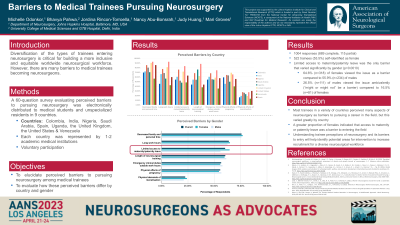Barriers to Medical Trainees Pursuing Neurosurgery
Friday, April 21, 2023

Has Audio

Michelle Odonkor (she/her/hers)
Medical Student
Johns Hopkins University School of Medicine
Baltimore, Maryland, United States
ePoster Presenter(s)
Introduction: Diversification of the types of trainees entering neurosurgery is critical for building a more inclusive and equitable worldwide neurosurgical workforce. However, there are many barriers to medical trainees becoming neurosurgeons. Both real and perceived, these barriers discourage qualified students from considering neurosurgery. Understanding these barriers and how they differ between trainee demographics and backgrounds will help optimize efforts to recruit a more representative workforce.
Methods: A 60-question survey evaluating perceived barriers to pursuing neurosurgery was distributed to medical students and unspecialized residents in 8 countries.
Results: 894 responses (805 complete, 89 partial) were received. 443 trainees (51.1%) self-identified as female.
61.9% (n=528) of respondents reported the length of neurosurgical training as a barrier to a career in the field. Other barriers reported included decreased family and personal time (75.3%, n=640), long work hours (64.4%, n=540), limited access to maternity or paternity leave (59.8%, n=505), and emergency clinical duties outside work hours (56.3%, n=473). Limited access to maternity or paternity leave was the only barrier that varied significantly by gender. A greater proportion of females (63.0%, n=266) viewed the issue as a barrier than males (56.7%, n=224) (p=0.0096), and a greater proportion of males (26.3%, n=104) viewed the issue ambivalently (“might or might not” be a barrier) compared to females (17.5%, n=74) (p=0.0096).
Conclusion : Our data highlight that most trainees in a variety of countries perceive many aspects of neurosurgery, such as long work hours and decreased personal time, as barriers to pursuing a career in the field. While many of these barriers were agreed upon between males and females, more females indicated that access to maternity or paternity leave was a barrier to entering the field. Understanding trainee perceptions of the field and its barriers to entry will help identify potential areas for intervention to increase recruitment for a diverse neurosurgical workforce.
Methods: A 60-question survey evaluating perceived barriers to pursuing neurosurgery was distributed to medical students and unspecialized residents in 8 countries.
Results: 894 responses (805 complete, 89 partial) were received. 443 trainees (51.1%) self-identified as female.
61.9% (n=528) of respondents reported the length of neurosurgical training as a barrier to a career in the field. Other barriers reported included decreased family and personal time (75.3%, n=640), long work hours (64.4%, n=540), limited access to maternity or paternity leave (59.8%, n=505), and emergency clinical duties outside work hours (56.3%, n=473). Limited access to maternity or paternity leave was the only barrier that varied significantly by gender. A greater proportion of females (63.0%, n=266) viewed the issue as a barrier than males (56.7%, n=224) (p=0.0096), and a greater proportion of males (26.3%, n=104) viewed the issue ambivalently (“might or might not” be a barrier) compared to females (17.5%, n=74) (p=0.0096).
Conclusion : Our data highlight that most trainees in a variety of countries perceive many aspects of neurosurgery, such as long work hours and decreased personal time, as barriers to pursuing a career in the field. While many of these barriers were agreed upon between males and females, more females indicated that access to maternity or paternity leave was a barrier to entering the field. Understanding trainee perceptions of the field and its barriers to entry will help identify potential areas for intervention to increase recruitment for a diverse neurosurgical workforce.
